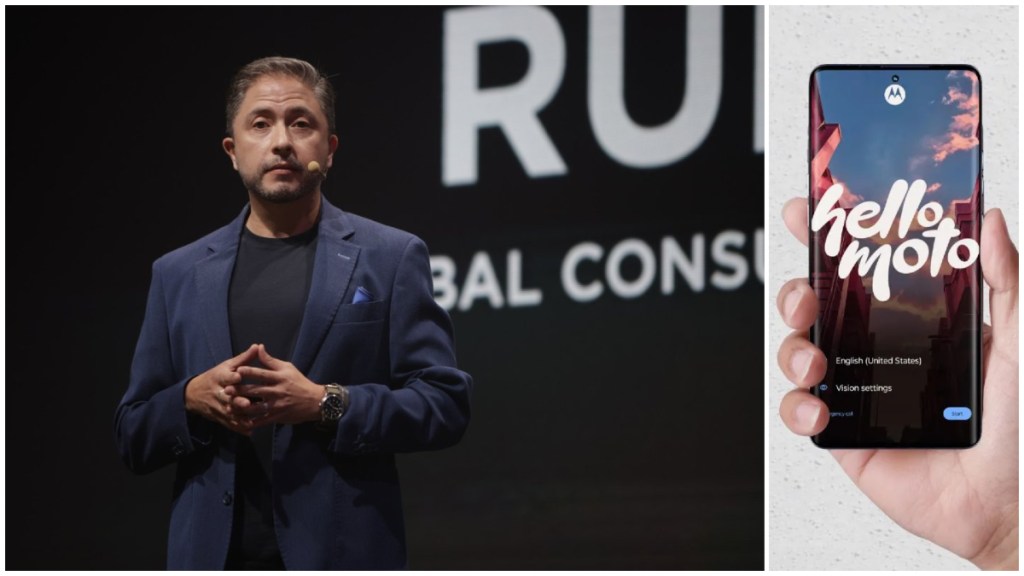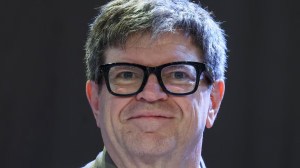Ruben Castano is the vice president of consumer experience and design at Motorola. But even more importantly, he has been with the company for almost two decades now. Having joined when Motorola was at its peak, on the back of the iconic Razr line of devices, he has seen the company go through numerous ups and downs over the years. Resilience is the word that comes to mind when you think of Motorola. The company that gave the world the first mobile phone simply refuses to die. In fact, it comes back stronger, each time.
“The people that work at Motorola are very resilient, because we’ve seen a lot,” Castano tells me on the sidelines of Motorola’s latest Edge 50 Pro launch.
Follow FE Tech Bytes on Twitter, Instagram, LinkedIn, Facebook.
Over the last few years, the company put all its focus on internal transformation that included setting up stage for more competitive products, improving cost and efficiency, basically, learning from competition and getting better. Getting that out of the way brought confidence. Motorola then quickly switched gears and started aspiring to become a lifestyle brand. The positive results brought more confidence.
“The momentum we have seen is giving us a lot of confidence that we are doing the right things,” Castano adds.
Motorola now wants to be a top three smartphone player and understands that India will be key to its success. So, if you’re wondering why the Edge 50 Pro had its global launch in India, well, let me tell you that it’s no coincidence. Castano calls India Motorola’s North Star, a market that seems to have a natural affinity to embrace a lot of the strategies that the company is developing.
Edited excerpts.
Motorola is a very resilient company, isn’t it? Where does that come from?
I would attribute it definitely to our history. [Whether it is] the first mobile phone, or the first communication from the Moon. Then obviously, the time when I joined, which was just when they had launched the first Razr. All that creates a lot of heritage and memory in consumers’ minds, and it’s something that just has an emotional bond with them, that makes them still want to be at least curious [about us]. We cannot expect for anything more, right. We want the market to be curious about what Motorola is doing. Then we have to do all the extra work to convince them to come back into our family of products. And yes, the people that work at Motorola, we are very resilient, because we’ve seen a lot.
And you’ve seen a lot clearly. Do you think the company continues to evolve with the times better than probably some of your other legacy competitors?
You know, without mentioning about our competitors, our own data shows that the answer to that is a yes. We had a few years where we focused heavily on transforming our company. I’ll give you some examples. Our products needed to be more competitive. Our time to market needed to improve. The cost structure of everything we were doing, needed to be solved as well. So, once we finished that phase of transforming our company, now we are really accelerating into what is our end goal for the next three years, which is to double our business, which in theory, should be taking us to becoming the number 3 brand in the world. The momentum we have seen to date, whether it’s in India or many other markets around the world, is giving us a lot of confidence that we are doing the right things. But make no mistake, it’s a very competitive market. We have to continue to be super focused on everything we do, and the key is continuing to be focused on the consumer and the strategies that we are developing which are very consumer centric.
What are your expectations from India as a market while chasing that end goal?
India is an extremely important market for us, not only from a volume perspective, which is significant, but that’s not the main driver for us. We are transforming our brand to being more of a lifestyle brand that [also] delivers great technology in a very differentiated way. The Indian market is a market that embraces colour, embraces differentiation, embraces a lot of the strategies that we are developing. So, for me personally and for my team, it’s not only a test ground, but actually a North Star for a lot of things that we do. We do them purposely for India because we know the importance that Indian consumers give to those aspects of the phone design. And beyond that, we have invested in local manufacturing, and we are growing from that aspect as well. We are investing in diversifying our channel strategy from online to retail and so on. Today, India is our largest market for our premium products, Edge [series] in particular. Indian consumers are not just price shoppers, they are looking for a really good value in where they spend their money, and we strive to do that as a brand.
The Pantone partnership is very interesting. Not a lot of people are probably aware of Pantone. But it’s a big differentiator for Motorola especially in a space where other brands generally tend to partner on camera and optics. Where does that idea come from?
You know, the idea of having a strategic partnership with Pantone came from the brand objective of becoming more of a lifestyle brand. That quickly took us to the conclusion that we need to be focused on design, on fashion, on colour trends and so on. And [all] that pointed us immediately to Pantone. They are the world’s authority in that space. They work behind the scenes with different industries, and they are not only working with those industries to tell them what they should be doing, they really understand consumer trends and macro trends, even social, political trends, and they understand how to translate all that into colour because we, as humans, always want to express our feelings and our emotions and colour is a very important medium to do that. So, they have this unique ability of understanding different industries, understanding trends and then translating all that into colour. They know this also months in advance. So, as a brand, it gives us a very strategic advantage because we know when we launch a certain device with the careful planning that we do with the Pantone team that once that product hits the shelves, consumers, whether they realise it or not, are getting influenced [by those choices]. It really helps us reposition our brand and very importantly, address the consumer segment that, to be honest, we were not really talking to before. We were very tech focused [before] and now we are very balanced. No product in our product development process passes certain gates unless it is very competitive, but that’s not enough. Then we need to build in this lifestyle, fashion and design layer into our products. That helps us then to talk to both the tech savvy consumers that are out there as well as the ones that definitely want to use the smartphone but are not buying it because of the tech specs. They don’t care or they don’t know what a chipset is or what a megahertz or a megapixel is.
Just to add to that, the whole “sensorial” experience is a big USP of your modern-day devices. Even the packaging comes with “Motorola fragrance.” Isn’t it a tad too much and do you think consumers notice these things?
The company that we have partnered with, Firmenich, they are the Pantone equivalent when it comes to fragrances and [are] developing flavours for many of the world’s [finest] industries that are out there. They understand what values we want to bring to life, and they develop the fragrance that [best] represents those values. Now that we have had close to a year of products in the field where when consumers open the box for the first time, and they are greeted with the Motorola fragrance, the feedback is extremely positive. It’s no reason to buy the device [of course] but it is a way for us of saying thank you. Thank you for trusting Motorola. Thank you for buying our device and here’s a sensorial experience that we hope you find gratifying. The answer has been yes, it is gratifying. And, you know, I hope in India we will see at one point, Motorola-branded stores, that’s another great place to play with the senses, fragrance being one of them. In other parts of the world where we do have Motorola-branded stores, we are already using that as a way to greet customers.
So, when do you plan to open these Motorola-branded stores in India?
I can’t comment about plans in India specifically. What I can say is that we are expanding both our online and physical presence in India. We are incrementing especially [on] the physical retail presence to get a good balance there. What I can say today is, if we want to be true to ourselves, if we’re placing so much emphasis on design, colour, materials, and finish, we have to find a way for consumers that go to a physical retail outlet to experience that. Otherwise, if they learn about a product and they want to go and see it physically and then they can’t experience it, we’ve lost the battle. So yes, I think there’s more to come, but again, we have to be coherent in what we’re doing and if we talk so much about this, we need to make sure it comes to life when a consumer is thinking about purchasing a Motorola device.
Most smartphone conversations are incomplete without AI today. It’s good that you’ve started to dip your toes into it. You’re still not quite there yet in terms of bringing generative AI to your devices but soon, maybe. What’s your strategy?
AI is a fantastic technology. It has so many different applications and it’s going to be a journey for us. Make no mistake, it’s not a gimmick. It’s not going to go away. We want to always see the technology that’s accessible to us and transform it into something meaningful. Why we started with camera, there’s actually a good reason. Consumers today, and this is based on our own research, they are predominantly capturing, creating and consuming content on a mobile. And so that’s the reason why in the Edge 50 Pro, we overemphasised on camera experiences and display. We went as far as validating the display and the camera with Pantone. So, what you see is what you’re actually also then seeing on the display and then AI has started to be infused into those experiences to improve it for the user. As more capabilities come, hopefully we can talk in future product announcements. But it’s a journey and we will be coherent in how we apply it.
I’d like to conclude with packaging. How long before you stop shipping chargers in the box – like your competitors?
In some markets around the world, we actually don’t put charger in the box, but it’s the result of understanding what consumers are asking for in that specific market, taking advantage of how they use the smartphone, acknowledging that they have access to already, maybe multiple chargers around their house. For the Indian market, I think that that’s still important. Will we get to a point where it makes sense to not include the charger in the box because we would prefer a lighter-weight packaging with less environmental impact, let’s have that conversation, when the time comes.
Is the Ultra coming to India?
The Ultra, meaning?
The Edge 50 Ultra?
We haven’t announced anything beyond the Edge 50 Pro [for now].







